Art Tools of Shari Blaukopf
Shari Blaukopf is an artist who strives to create a painting every day on her blog The Sketchbook.
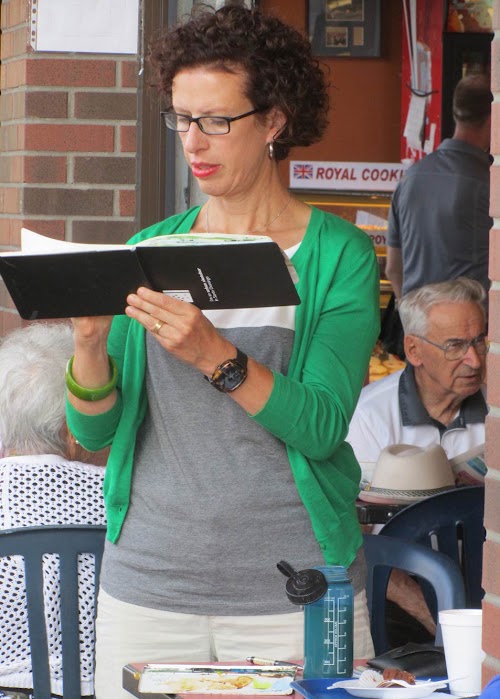
She paints with watercolours predominately. Her use of colours, and the play with shapes are wonderful.
You should check out her many paintings at on her Flickr page www.flickr.com/photos/70010386@N08
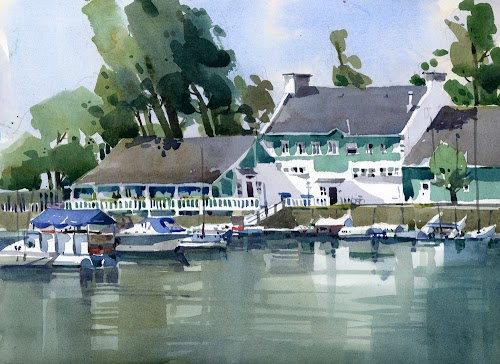
Let's see what her drawings tools are.

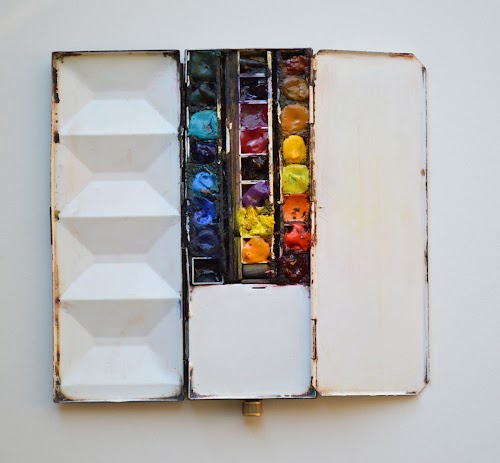
Qn: Alright, the first thing that grabbed my attention is the watercolour box because I've a variation of that box. What watercolour box is this? How do you like it? Do you use that integrated water bottle much? And, of course, where did you buy it?
That box is a modified Daniel Smith travel palette and it’s a hand-me down from my mother who originally bought it but doesn’t paint any more. It comes with space for 16 half-pans and room in the middle for a travel brush.
As you can see I added some pans so I can have a broader selection of pigments. I love this box because of the enamel mixing surface. I have a plastic palette too but it’s just not as nice to mix colours in. This box has been in my painting bag for over two years, so it’s starting to rust a bit and it doesn’t close properly but I won’t give it up.
The water reservoir on the palette is useless because you can fill it but the water doesn't come out. And the water cup always fall off!
Qn: What watercolours do you use? It looks to me like you fill the pans with watercolour tube paints?
I do use tube paints and try to freshen up the colours every week. If they get dry I give them a little spray of water from a tiny bottle I carry in my bag. Believe it or not I cleaned the box before taking the photo! When I’m painting a lot the little pans get a bit mucked up around the edges but every so often I give the whole box a good scrubbing to get rid of the dried bits of paint.
Pan colours are good too if they are fresh I have seen too many sketchers with dried and cracked colours that they try to reconstitute. After adding all that water you just can’t get good saturated washes any more.
I am not loyal to one brand of watercolour although I do stick to artist quality pigments. If I find a good sale I stock up on Winsor Newton, Holbein or Daniel Smith, although this past summer I discovered M. Graham paints. They are honey-based, and although I love their creaminess, some of the colours (such as Cerulean blue) can get very runny if you don’t give them enough time to air-dry before leaving the house. Two to three days is ideal but I don’t always do that. There’s too much sketching to be done!
Qn: Is there any particular way to your arrangement to your colour palette? And what's that thing in the middle row just beside the orange colour?
The colours on the outside are the ones I use most often. I guess I have a classic arrangement of colour. Starting from the top right I have the earth colours like Burnt and Raw Sienna, Yellow Ochre and then cool and warm yellows and reds. On the left side I have the cool and warm blues and greens. The middle is reserved for the colours I use less frequently, such as purples and pinks, although my favourite yellow (M. Graham’s Azo Yellow) is in the middle too.
I modified the box by adding those half pans in the middle and just to make sure everything stays in there nice and tight I added a few popsicle sticks and a small piece of wooden dowel shaved down to the right size. That’s what’s next to the orange colour.


Alternate view of selected brushes
Qn: That's a lot of brushes. Rather than going through all of them, why not tell use which ones are your favourites or the more commonly used ones?
I always leave the house with too much equipment in my bag, including a redundancy of brushes! My favourites are the ones I selected for the photo with the palette and pens.
I have a great big Raphael #14 Kolinsky sable (with the orange end) that I use to start off most paintings. It holds tons of wash and can come to a good, fine point. It costs a bomb but I found it on sale at Pearl Paint in New York so I bought it. Last year I lost it while giving a workshop and that just killed me so I replaced it with a new one. Nothing else in my kit is that expensive. My other favourites are the Escoda Perla synthetic brushes. I use these for all the fine work and details. They have a wonderful spring to them and never seem to lose their points. I think I’ve made many converts to these brushes at workshops.
The other brushes that I always use are fine riggers, although I probably use them more for power lines than boat rigging.
I also love big flat brushes, although I use them more in large paintings than in small sketchbooks. I have a 2-inch flat and a 1.5-inch flat as well as an assortment of smaller flats.
Qn: I see several rather similar brushes. For example there quite a few thin round brushes, and several flat brushes on the right. What are the differences between the similar looking brushes?
They mostly all serve the same purpose as what I described above: Extra riggers, a few scraggy brushes for making tree branches and an assortment of flats. I guess my brush holder is too big and I just expand my brush collection to fill the space.
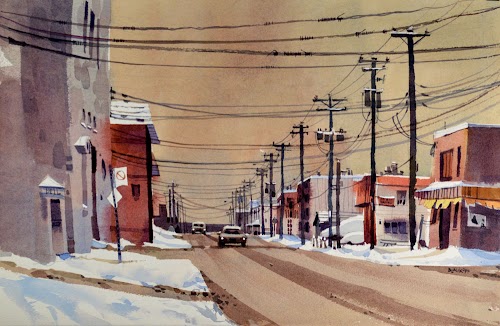
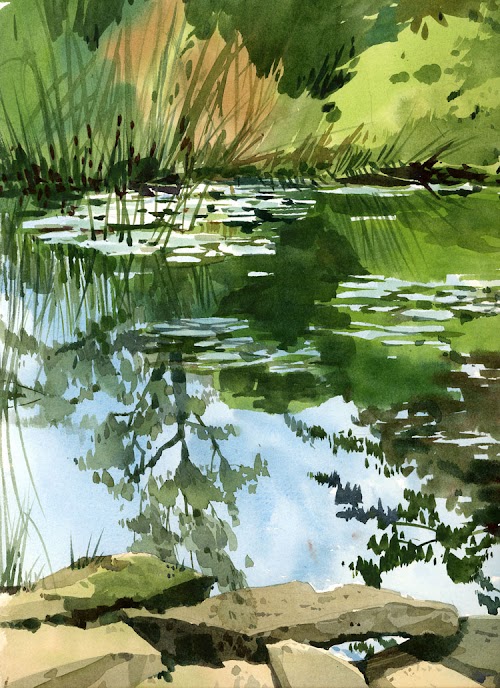
Qn: What watercolour paper do you use?
I love trying out new papers and my current favourites are Fabriano soft press and Saunders Waterford cold press. I used Arches for years but it doesn’t really work for me anymore. I find it too stiff and textured. I prefer a softer and less textured paper like Fabriano.

Qn: Do you use sketchbooks? From your Flickr page, it seems like you prefer drawing on loose sheets?
When I started my daily sketch blog a few years ago I worked almost exclusively in a Moleskine watercolour book (5” x 8”) but I recently switched to loose sheets.
I exhibit and sell my work as part of an artists group in my community and I don’t want to cut work out of books so I started working on loose sheets.
Of course it’s always preferable to work with 100% cotton rag paper and that is hard to find in a book. Recently I have tried out the Stillman & Birn Beta series and have been having a lot of success with those.
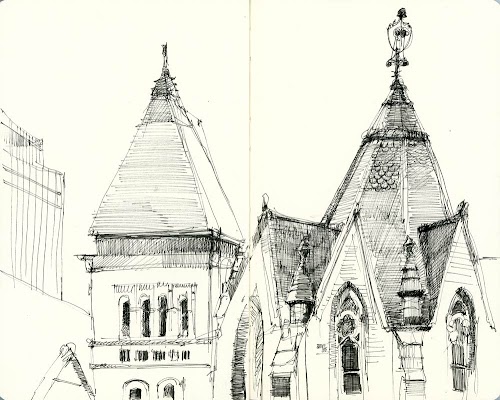

Qn: Can you give us a rundown of the pens you use? Do they work well with watercolour sketches?
My favourite pen is the Micron 005. I just can’t find another pen that has that fine a tip, but they wear down really quickly so I do carry other brands in my bag. I know a lot of sketchers use the Lamy pens but I find them too thick and not flexible enough. I love writing with them but for drawing they just don’t have enough give.
Qn: Where are there two different 0.05 multiliner pens? The Staedtler and the Micron.
The Staedtler and the Sharpies are my substitutes if I run out of Microns, but I just don’t love them as much as that Micron.
Qn: I noticed there are no pencils. Do you use pencils for drafting before you add in the watercolours or line art?
I do have a pencil in the mix. It is just to the left of the palette in the group shot. Again, a very favourite tool that I always make sure is in my bag. It is a mechanical pencil that I bought at the MOMA shop in New York City. It is from MUJI, a Japanese store that has a little boutique in New York. The pencil feels perfect in my hand and for a while I had just one that I was always afraid to lose but I bought a few more last time I visited New York.
Qn: Who else do you think we should feature next?
I think you should feature Paul Wang. I love his playful sense of colour.
Ian Sidaway creates magic with really fine lines in his work. I wonder what pens he uses.
And lastly I would love a look into Wil Freeborn’s sketch kit.

Check out more art from Shari Blaukopf at https://shariblaukopf.com
Comments?
Send them to https://shariblaukopf.com/2014/01/30/art-tools-and-a-little-demo/
Items mentioned may be available at Dick Blick Art Materials, Amazon.com and Amazon.co.uk



Comments
Your art inspires me - I try
Your art inspires me - I try to do a painting a day, but life gets in the way sometimes. How do you manage?